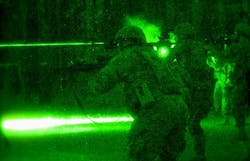Army night-vision researchers look to Raytheon to develop advanced IR focal plane arrays
Officials of the Army Contracting Command Aberdeen Proving Ground-Belvoir Division at Fort Belvoir, Va., announced plans this week to award a sole-source research contract to Raytheon to provide III-V infrared focal plane array (FPA) fabrication development. The value of the contract has yet to be negotiated.
Specifically, Raytheon electro-optics scientists will refine and demonstrate high-performance infrared FPA technologies that are capable of mid-wave infrared (MWIR), long-wave infrared (LWIR), and LWIR/dual-band detection, Army officials say.
Related: Army seeks companies able to develop advanced infrared detectors for military applications
The Army contracting command is awarding the contract to Raytheon Vision Systems on behalf of the Army Night Vision & Electronic Sensors Directorate (NVESD) at Fort Belvoir. Raytheon Vision Systems is formerly the Santa Barbara Research Center (SBRC).
The two-year contract to Raytheon will be a follow-on to the Vital Infrared Sensor Technology Acceleration (VISTA) program, and will capitalize on the research done previously to refine and develop advanced infrared technologies, Army researchers say.
Raytheon Vision Systems is the only one responsible source for the kind of research and development that Army night-vision researchers need, so the contract will be awarded sole-source, officials say.
Other companies whose leaders believe they could do this kind of work should email the Army's Elizabeth Bray no later than 27 Feb. 2014 at [email protected]. Army researchers may reconsider and open the project to competition.
Army work involving III-V infrared focal plane array based sensors includes III-V superlattice large format, small pixel mid wave infrared (MWIR), long wave infrared (LWIR), very long wave infrared (VLWIR), and dual-band (MW/LW, LW/LW, and short wavelength [SW]/LW) detector arrays.
Military applications for this kind of technology include wide-area overage for situational awareness; detection of plumes and gunflashes detection; infrared search, identification and tracking; missile detection and interception; and hyperspectral imaging.
Related: FLIR Systems to design thermal imaging sensors for Navy and Coast Guard patrol boats
Related Army research also involves high-performance low cost III-V epitaxial wafers at increasing size; large gallium antimonide substrates with improved quality; advanced readout integrated circuits supporting advanced III-V detectors; FPA hybridization including small pixels, thermally compatible FPA packaging; and integrated cooler and dewar assembly (IDCA) units.
For more information contact Raytheon Vision Systems online at www.raytheon.com, or the Army Night Vision and Electronic Sensors Directorate at http://www.nvl.army.mil/.

